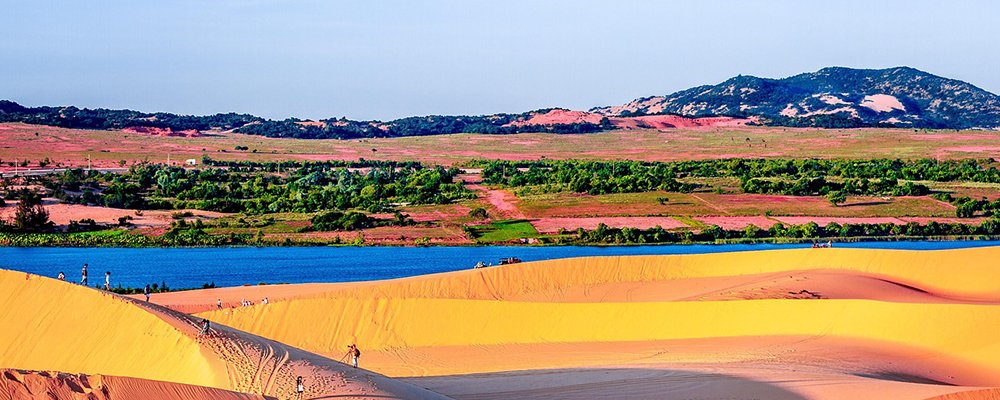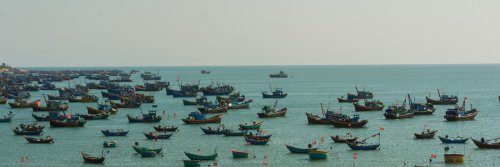Mũi Né in Vietnam seems to provoke two reactions: you either love it or hate it. The resort lies around four hours east of bustling Ho Chi Min City and has become either a weekend retreat for local city-types, or a convenient stopover for travellers on the road seeking to strike north for Nha Trang.
Admittedly, looking at the map, it is pretty easy to overlook the town of Mũi Né as it appears to sit quite apart from anywhere on the Vietnamese coast. For travellers looking to balance budgets and the rush to reach north or south destinations, depending on their routes, the town can be easily erased from itineraries.
However, Mũi Né was a welcome beach resort of choice for us, having survived the heat and unrelenting city beat of Ho Chi Minh City. An escape, with a view to connecting up to Nha Trang, was in order, and the town was just the pick-me-up we needed.
Agreeably, most travellers who have seen it, done it and moved on recommend no more than two to three days in the resort, Mũi Né, with its long, palm-lined stretch of sand, lingered for us. Probably, the simple joys of getting up, wandering around, reading a book, and having time to do what we wanted without being boxed in on scheduled tours was a delight.
Why Mũi Né?
Admittedly, Mũi Né is not everyone's 'happy place'. Getting there can be a hassle. As it's not on a rail stop, a sleeper bus was our choice heading out of Ho Chi Minh City. And on arrival, it looked as if we had landed in another synonymous coastal destination.
A main road carves through the middle of the resort, and views of the beach and sea are only glimpsed through the buildings that hug the coastal side. Blocking out the usual signs of bars, massage parlours and hotels, once you get to the beachfront, it is ok, although it's only a few metres wide.
Once in your resort, you can pretty much forget the outside surroundings and dig in for a couple of days' respite. There are various accommodation types and budgets, and quality does range! For those seeking a little luxury, try The Anam Mui Ne, which opened two years ago.
Getting out and about was fairly straightforward, and we were able to enjoy some eateries and restaurants along the way. Although most don't have a sea view as they are on the main road, the food was of good quality, and nothing to complain about. Prices were consistent with our stay in Vietnam.
Some of the highlights of Mũi Né were watching the surfers do their thing on the waves, experiencing yet more memorable sunsets, and just frankly chilling in our journey.

What Is There To Do?
The surfing community chasing the waves around the Mũi Né region will give you a great idea of where to enjoy the best rides. Inevitably, there are surf shops, so local information is pretty much available. Kite-surfing is also another pursuit to consider if you're into adventure. Surf's up usually runs from November but, ideally, from February through March.
Oddly, Mũi Né, for all its rough-edge charms and faded glory, became a perfect springboard to other trips in and around the region.
These included a hike to Ta Cu Mountain for a fix of Buddha: pagodas, statues, history and the biggest reclining Buddha in Vietnam. One bonus could be the cable car trip, which affords you some fantastic views.
Locally, there are many trips on offer. These inevitably include a trip to the white sand dunes, a look at a fishing village, the red sand dunes and a walk through a fairy stream to a waterfall.
These are usually wrapped around a sunrise tour, so it's a case of early to rise to catch this one.
The white sand dunes (Doi Cat Trang) are an ideal start to catch the early sun's rays, although there is potential for a quick ride around on an ATV. We opted for a stroll on the dunes, saw the sun rise and then headed back for the rest of the tour.
As a keen photographer, the potential of the fishing village and its many images posed great potential. In fact, this could have been developed into a slower trip to linger longer to get the sights, smells and sounds of a working village.
That said, the red sand dunes (Doi Hong) are a delight, particularly if you come down on a sand board for the sheer thrill of it. Onwards, the fairy stream runs alongside colourful and impressive rock and sand formations.
Finally
Admittedly, Mũi Né is not for everyone, and others would argue that three days here could be better invested elsewhere. But Mũi Né still has its charms, enough to justify a visit on the Vietnam trail.
 Andy Probert is an independent journalist who writes about global travel news, airlines, airports, and business. His work has appeared globally on the BBC, and in many national newspapers and magazines.
Andy Probert is an independent journalist who writes about global travel news, airlines, airports, and business. His work has appeared globally on the BBC, and in many national newspapers and magazines.















